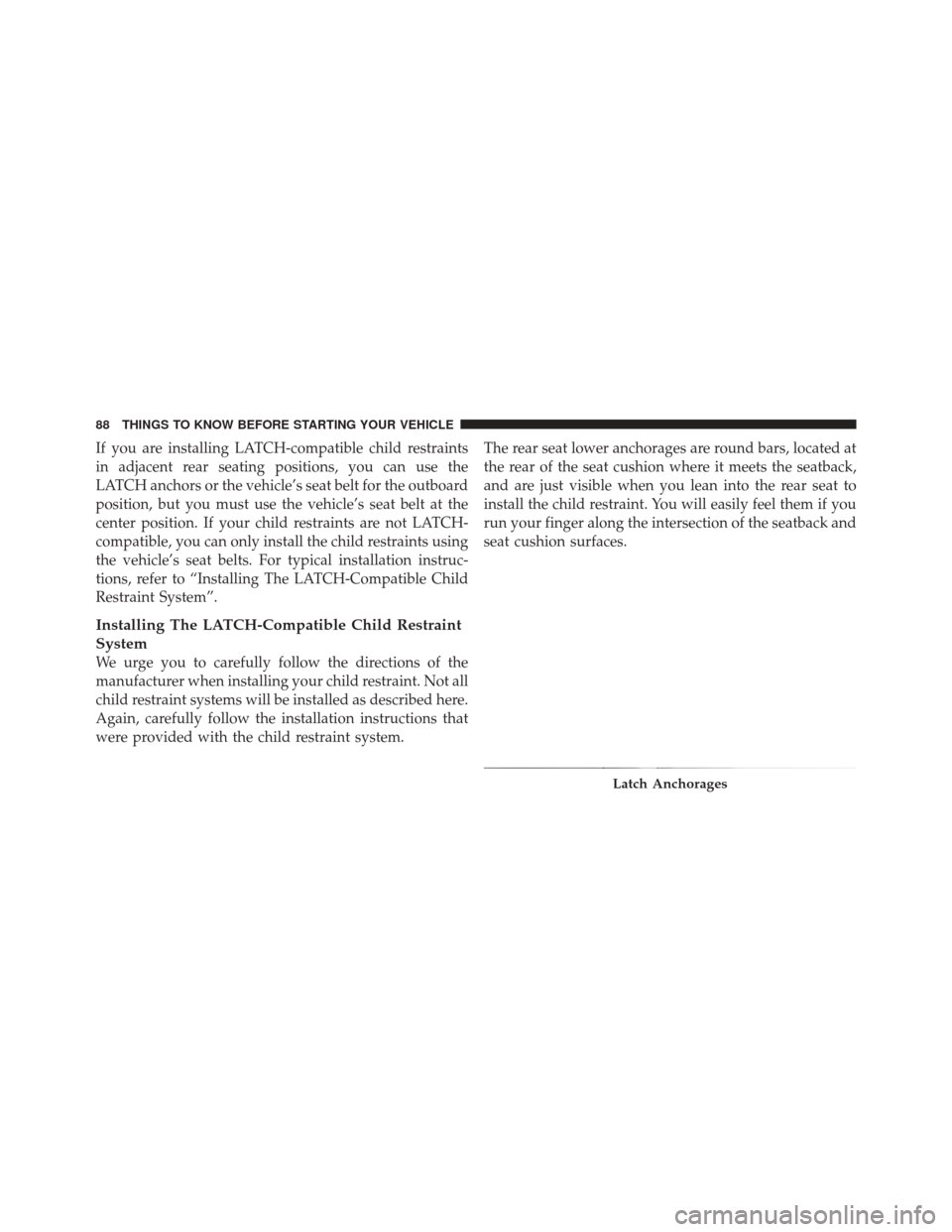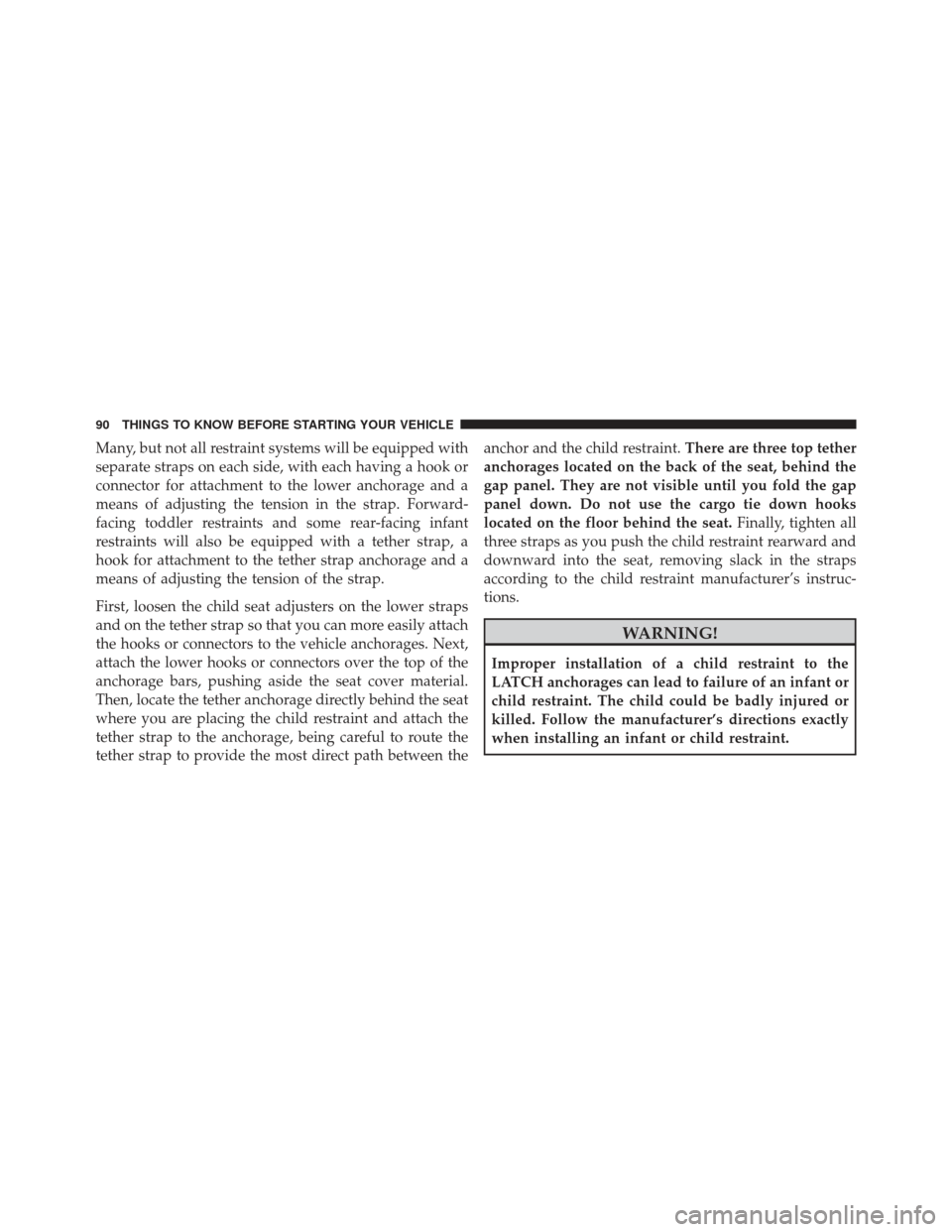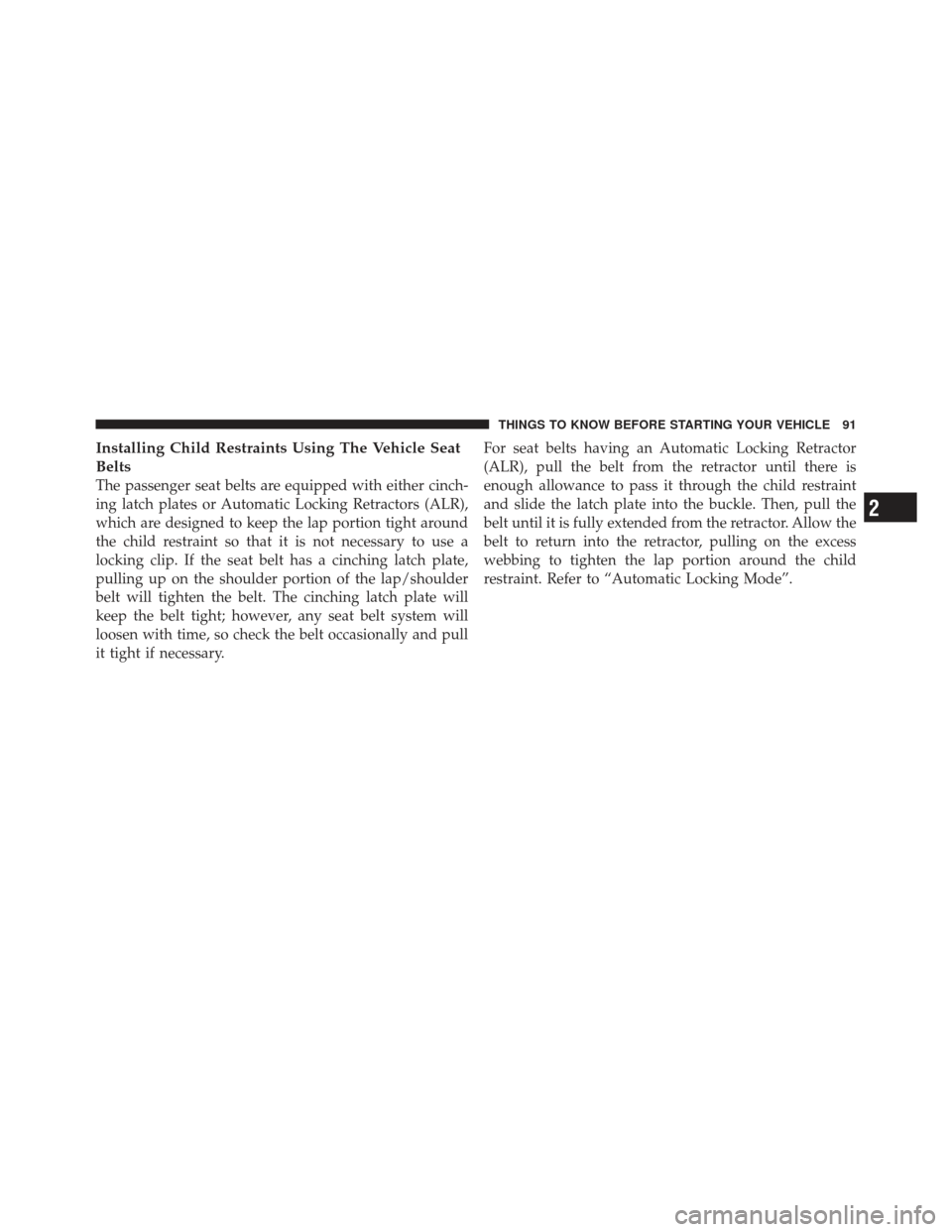Page 90 of 587

If you are installing LATCH-compatible child restraints
in adjacent rear seating positions, you can use the
LATCH anchors or the vehicle’s seat belt for the outboard
position, but you must use the vehicle’s seat belt at the
center position. If your child restraints are not LATCH-
compatible, you can only install the child restraints using
the vehicle’s seat belts. For typical installation instruc-
tions, refer to “Installing The LATCH-Compatible Child
Restraint System”.
Installing The LATCH-Compatible Child Restraint
System
We urge you to carefully follow the directions of the
manufacturer when installing your child restraint. Not all
child restraint systems will be installed as described here.
Again, carefully follow the installation instructions that
were provided with the child restraint system.The rear seat lower anchorages are round bars, located at
the rear of the seat cushion where it meets the seatback,
and are just visible when you lean into the rear seat to
install the child restraint. You will easily feel them if you
run your finger along the intersection of the seatback and
seat cushion surfaces.
Latch Anchorages
88 THINGS TO KNOW BEFORE STARTING YOUR VEHICLE
Page 91 of 587
In addition, there are top tether strap anchorages behind
each rear seating position located on the back of the seat.
To access the top tether strap anchorages behind the rear
seat, pull the carpeted floor panel away from the seat
back, this will expose the top tether strap anchorages.
WARNING!
Do not use the cargo tie downs located on the load
floor. Improper usage of the tether can lead to a
failure of an infant or child restraint. The child could
be badly injured or killed.
Pulling Down The Carpet Floor PanelTo Access Top Tether Strap
Top Tether Strap Anchorage (Located on Seatback)
2
THINGS TO KNOW BEFORE STARTING YOUR VEHICLE 89
Page 92 of 587

Many, but not all restraint systems will be equipped with
separate straps on each side, with each having a hook or
connector for attachment to the lower anchorage and a
means of adjusting the tension in the strap. Forward-
facing toddler restraints and some rear-facing infant
restraints will also be equipped with a tether strap, a
hook for attachment to the tether strap anchorage and a
means of adjusting the tension of the strap.
First, loosen the child seat adjusters on the lower straps
and on the tether strap so that you can more easily attach
the hooks or connectors to the vehicle anchorages. Next,
attach the lower hooks or connectors over the top of the
anchorage bars, pushing aside the seat cover material.
Then, locate the tether anchorage directly behind the seat
where you are placing the child restraint and attach the
tether strap to the anchorage, being careful to route the
tether strap to provide the most direct path between theanchor and the child restraint.
There are three top tether
anchorages located on the back of the seat, behind the
gap panel. They are not visible until you fold the gap
panel down. Do not use the cargo tie down hooks
located on the floor behind the seat. Finally, tighten all
three straps as you push the child restraint rearward and
downward into the seat, removing slack in the straps
according to the child restraint manufacturer’s instruc-
tions.
WARNING!
Improper installation of a child restraint to the
LATCH anchorages can lead to failure of an infant or
child restraint. The child could be badly injured or
killed. Follow the manufacturer’s directions exactly
when installing an infant or child restraint.
90 THINGS TO KNOW BEFORE STARTING YOUR VEHICLE
Page 93 of 587

Installing Child Restraints Using The Vehicle Seat
Belts
The passenger seat belts are equipped with either cinch-
ing latch plates or Automatic Locking Retractors (ALR),
which are designed to keep the lap portion tight around
the child restraint so that it is not necessary to use a
locking clip. If the seat belt has a cinching latch plate,
pulling up on the shoulder portion of the lap/shoulder
belt will tighten the belt. The cinching latch plate will
keep the belt tight; however, any seat belt system will
loosen with time, so check the belt occasionally and pull
it tight if necessary.For seat belts having an Automatic Locking Retractor
(ALR), pull the belt from the retractor until there is
enough allowance to pass it through the child restraint
and slide the latch plate into the buckle. Then, pull the
belt until it is fully extended from the retractor. Allow the
belt to return into the retractor, pulling on the excess
webbing to tighten the lap portion around the child
restraint. Refer to “Automatic Locking Mode”.
2
THINGS TO KNOW BEFORE STARTING YOUR VEHICLE 91
Page 94 of 587
To attach a child restraint tether strap:
For rearward facing infant seats secured in the center seat
position with the vehicle seat belts, the rear center seat
position has an armrest tether that secures the arm rest in
the upward position. To access the center seat arm rest
tether first lower the arm rest. The tether is located
behind the armrest and hooked onto the plastic seat
backing.Pull down on the tether to unhook it from the plastic seat
backing, then raise the armrest and attach the tether hook
to the strap located on the front of the arm rest.
Center Seat Position Arm Rest Tether
92 THINGS TO KNOW BEFORE STARTING YOUR VEHICLE
Page 97 of 587

WARNING!
•An incorrectly anchored tether strap could lead to
increased head motion and possible injury to the
child. Use only the anchor positions directly be-
hind the child seat to secure a child restraint top
tether strap.
•Do not use the cargo tie downs located on the load
floor. Improper usage of the tether can lead to a
failure of an infant or child restraint. The child
could be badly injured or killed.
Top Tether Strap Attachment
For the center seating position route the tether strap over
the seatback and headrest then attach the hook to thetop
tether anchorage located on the back of the seat behind
the gap panel. For the outboard seating positions, route
the tether strap under the headrests and attach the hook
to the top tether anchorage located on the back of the seat behind the gap panel. Please note the top tether anchor-
ages are not visible until you fold the gap panel down.
Do not use the cargo tie down hooks located on the
floor behind the seats.
Transporting Pets
Airbags deploying in the front seat could harm your pet.
An unrestrained pet will be thrown about and possibly
injured, or injure a passenger during panic braking or in
an accident. Pets should be restrained in the rear seat in
pet harnesses or pet carriers that are secured by seat belts.
ENGINE BREAK-IN RECOMMENDATIONS
A long break-in period is not required for the engine and
drivetrain (transmission and axle) in your vehicle.
Drive moderately during the first 300 miles (500 km).
After the initial 60 miles (100 km), speeds up to 50 or
55 mph (80 or 90 km/h) are desirable.
2
THINGS TO KNOW BEFORE STARTING YOUR VEHICLE 95
Page 98 of 587

While cruising, brief full-throttle acceleration within the
limits of local traffic laws, contributes to a good break-in.
Wide-open throttle acceleration in low gear can be detri-
mental and should be avoided.
The engine oil installed in the engine at the factory is a
high-quality energy conserving type lubricant. Oil
changes should be consistent with anticipated climate
conditions under which vehicle operations will occur. For
the recommended viscosity and quality grades refer to
“Maintenance Procedures” in “Maintaining Your Ve-
hicle”. NON-DETERGENT OR STRAIGHT MINERAL
OILS MUST NEVER BE USED.
A new engine may consume some oil during its first few
thousand miles (kilometers) of operation. This should be
considered a normal part of the break-in and not inter-
preted as an indication of difficulty.SAFETY TIPS
Transporting Passengers
NEVER TRANSPORT PASSENGERS IN THE CARGO
AREA.
WARNING!
•Do not leave children or animals inside parked
vehicles in hot weather. Interior heat build-up may
cause serious injury or death.
•It is extremely dangerous to ride in a cargo area,
inside or outside of a vehicle. In a collision, people
riding in these areas are more likely to be seri-
ously injured or killed.
•Do not allow people to ride in any area of your
vehicle that is not equipped with seats and seat
belts.
•Be sure everyone in your vehicle is in a seat and
using a seat belt properly.
96 THINGS TO KNOW BEFORE STARTING YOUR VEHICLE
Page 138 of 587
The center head restraint has limited adjustment. Lift
upward on the head restraint to raise it, or push down-
ward on the head restraint to lower it.WARNING!
Sitting in a seat with the head restraint in its lowered
position could result in serious injury or death in a
collision. Always make sure the outboard head re-
straints are in their upright positions when the seat is
to be occupied.
NOTE: For proper routing of a Child Seat Tether refer to
“Occupant Restraints” in “Things to Know Before Start-
ing Your Vehicle” for further information.
Rear Head Restraint
136 UNDERSTANDING THE FEATURES OF YOUR VEHICLE